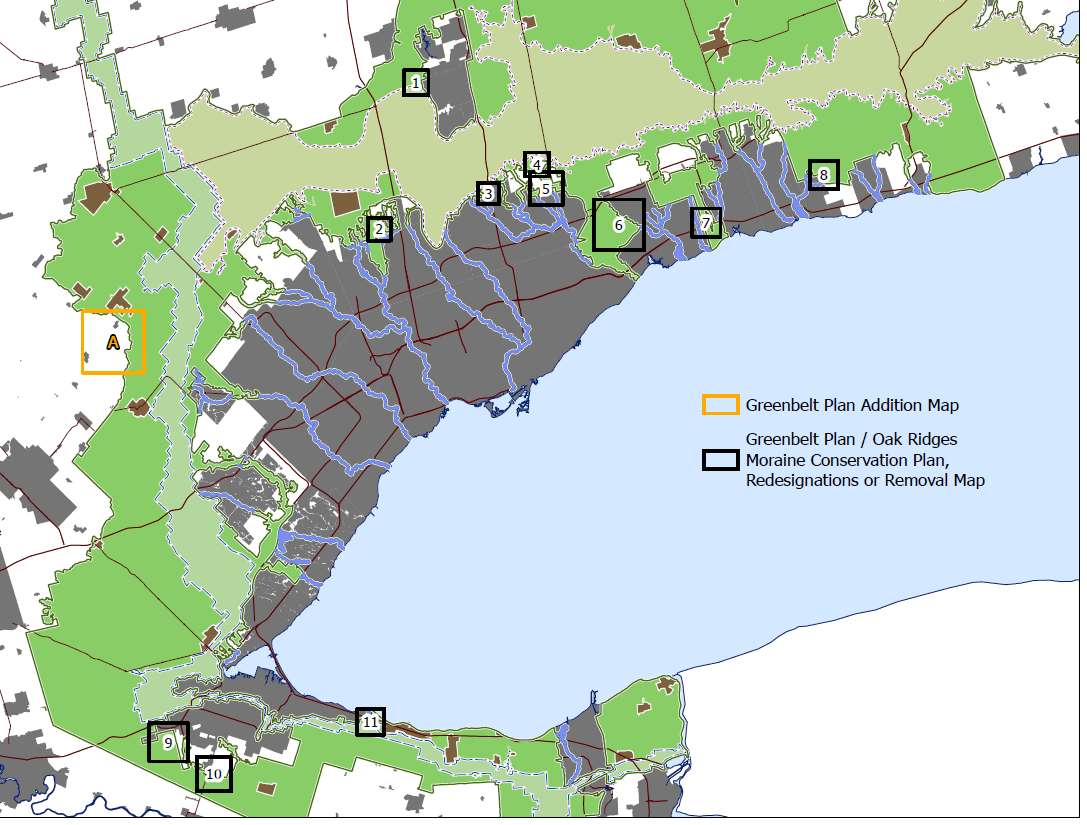 By Pepper Parr
By Pepper Parr
November 4th, 2022
BURLINGTON, ON
When a media release comes out any time after 2:00 pm on a Friday – look it over very carefully.
Should it come out after 2:00 pm on a long holiday weekend – you know that trouble is coming your way.
Today, after 2:00 pm in our part of the world, the weather is wonderful. Who wants to be in the office or even at the keyboard if you are at home.
Here is what the provincial government slipped into thousands of email boxes.
Ontario is expected to grow by more than two million people by 2031, with approximately 1.5 million of those new residents in the Greater Golden Horseshoe Region. This growth was recently confirmed by the federal government’s newly released immigration targets. To accommodate that growth and support the building of more homes, our government is proposing to remove 15 areas of land totalling approximately 7,400 acres from the edge of the Greenbelt area.

Nothing in Burlington that is threatened.
At the same time, we are proposing to add an additional 9,400 acres to the Greenbelt, including a portion of the Paris Galt Moraine and 13 urban river valleys in the Greater Golden Horseshoe, for an overall Greenbelt expansion of approximately 2,000 acres.
These proposed changes to the Greenbelt meet the following criteria, all of which must be met before a property is given consideration:
-
-
-
- Greater than 1:1 offset must be achieved to ensure overall Greenbelt expansion
- Affected areas must have the potential for homes to be built in the near future
- Affected areas must be adjacent to the existing Greenbelt boundaries
- Affected areas must be adjacent to an existing urban area
- Affected areas must be on or near readily serviceable land, with local infrastructure upgrades needed to service the projects to be funded entirely by the proponents
-
-
Should these lands be removed from the Greenbelt, the landowners will be expected to develop detailed plans to build housing quickly. It is the government’s expectation that new home construction will begin on these lands by no later than 2025, and that significant progress on approvals and implementation must be achieved by the end of 2023. If these conditions are not met, the government will return these properties to the Greenbelt.
These changes are an important part of our government’s balanced strategy to build a stronger Ontario by protecting environmentally important lands while tackling Ontario’s housing supply crisis. We are fulfilling our commitment to get more homes built faster so more Ontarians can find a home that meets their needs and budget.
There is nothing in the current greenspace incursion that is going to take place that has an immediate and direct impact on Burlington.
Hamilton has a number of areas that will create a lot of concern
Know that the development community is poring over their holdings and figuring out just where the opportunity is for them.
Who is going to be looking after the public interest.
There is a lot of very useful information in the link below. If you want to know what is involved and look at the maps
Comments on these proposals are welcome through the Environmental Registry of Ontario by December 5, 2022.”
Peter Tabuns, Interim Ontario NDP Leader and Climate Crisis critic, released the following statement in response to the Ford government’s latest scheme to remove protected land from the Greenbelt:
“It’s disturbing that Doug Ford is taking another run at punching holes in the Greenbelt.
















Chris.
While I agree with you that gentle (other creative forms of ground oriented infilling instead of only single family homes or McMansions) should be used to intensify and reduce overall costs of housing by lot splitting and costs to the City
in the low density areas.
You, I hope are aware that 87% of Ontario land is Crown land owned by the Province. Much of the rest is forest and farmlands. Canada is a massive country and suggesting even remotely that it is getting overdeveloped or crowded is a big stretch of the truth.
Adam. You hit the nail on the head. The fools appear to have no idea what they want built and where. Or if they want anything built at all. The know nothing Nimby’s and a do nothing Mayor. Have set the stage for the Provincial Government to push them aside, get them out of the way and get back to business. As you said. Not everyone wants to live in a condo and the Provincial Government mandates that all Cities provide a wide variety of housing choices.
Chris you may want to provide the other political parties platforms to see if they differ from the Conservatives in housing matters. I would suggest they are all on the same page. From what I understand Burlington is unaffected by these changes???
Meanwhile Trudeau brings in 500,000 newcomers a year with no idea where to put them. Yet no blame gets put on him. Sort out where the housing shall be built first. Then invite everyone in.
Chris, from your comments I must assume that you live in a small condo or apartment building next to transit? Is that how you expect all the new immigrants (over 500,000 in 2025) to live? Are they all supposed to live in condos downtown? Oh I forgot, no one wants those built either. All these comments about development, but no one has credible plans for how to house our growing population – can’t build on farmland, no more sprawl, no tall buildings, too many small units not big enough for families, too much traffic etc. I think this government got fed up because no one wants anything built anywhere.
A lot to unpack in your comment, Adam…there are so many ways to address our housing crisis that don’t involve putting housing on rural lands that are remotely feasible for municipalities to connect to services at massive cost to the taxpaying public, and permanently reduce our flood protection, green canopy and food security. Milton and Halton Hills have enough single-family housing neighbourhoods already planned to handle their growth for at minimum the next 15 years, probably 25 at the pace the development is actually happening. Most people understand that the 1950’s planning where we keep building outwards and “drive til you qualify” is not a tenable situation. This idea that 75% or more of the land within cities is off-limits because it happens to be near people, as well as to the services people need and existing roads and transit, has to be resolved. So does the idea that storage for cars is the most important concern to be regulated, and providing enough places for people to live comes second. Just allowing granny suites isn’t enough if you still impose parking minumums and other zoning restrictions that make it hard to actually provide gentle density and bring back the ecosystem of small-scale developers that we used to have. Many neighbourhoods in Burlington have a declining population due to aging and a lack of affordability and thus services like schools are closing and businesses serving these areas are having a tougher time staying solvent. These neighbourhoods need growth from infill to stay viable, but this is opposed out of fear that some undesirables who can only afford an $800K townhome or a $1 million semi might move in. So instead they end up selling to wealthy folks who tear down affordable neighbourhood homes not to construct multi-family homes, but McMansions. The aging population needs available places to downsize within the neighbourhoods they feel at home in. Industry has been offshoring for the last 40-50 years, and with the need for national security and avoiding supply chain disruptions, we will see manufacturing starting to come back. Employment lands like Bronte Meadows are essential to ensure we continue to grow our jobs base along with the population. And instead of shifting the resources towards building less homes farther away from jobs & services, we need to double down on setting up and educating workers to enter the trades that are right now one of the biggest constraints on development in the province. The Greenbelt is not constraining development of housing supply at all, it’s decades of appeasing speculators and regulations meant to freeze the natural evolution of most existing housing lands in the region that have led to the supply crunch.
And that’s not all. Even worse, the provincial government has decreed changes to Halton’s Official Plan ROPA 49, including the Bronte Meadows converted from employment lands, and parts of the rural area north of Aldershot designated as “new community area”. This government has every intention of locking as much expensive sprawl as possible in perpetuity which municipal taxpayers will have to foot the bill for. Land speculators thank the Consumeative voters for giving Ford the mandate to reward their contributions to his campaign behind the false cover of “building more housing”. In fact, these decisions will likely result in much less housing actually getting built as the limited supply of tradespeople, building materials and planning resources get diverted from more efficient land-use patterns in order to build large unaffordable single family homes on cul-de-sacs at fringe areas like North Aldershot. The promise not to touch the Greenbelt is as good as dead in this backwards province. Wonder what Natalie Pierre and Effie T. have to say about what they’ve done to the people of Burlington and Halton among others?